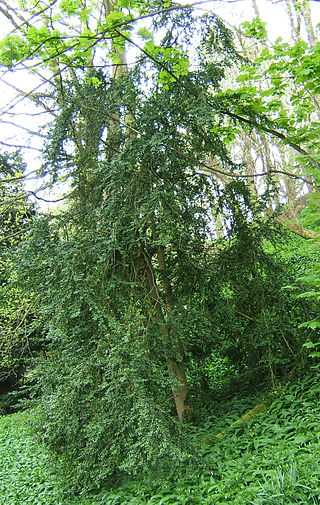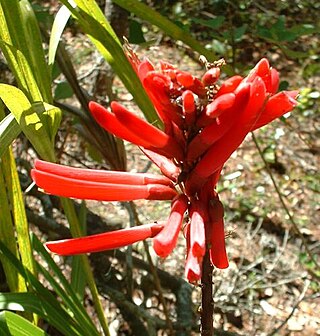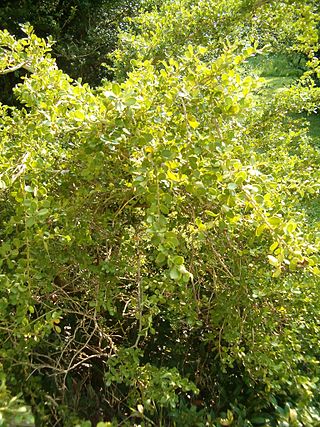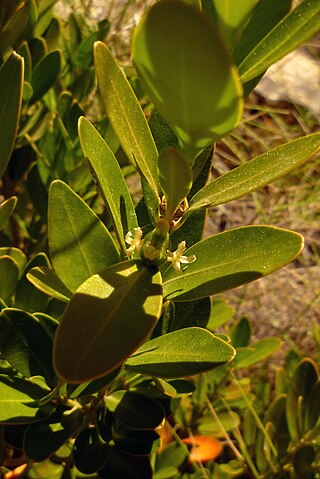
Erica arborea, the tree heath or tree heather, is a species of flowering plant (angiosperms) in the heather family Ericaceae, native to the Mediterranean Basin and Ethiopia, Kenya and Tanzania in East Africa. It is also cultivated as an ornamental.

Robinia pseudoacacia, commonly known in its native territory as black locust, is a medium-sized hardwood deciduous tree, belonging to the tribe Robinieae of the legume family Fabaceae. It is endemic to a few small areas of the United States, but it has been widely planted and naturalized elsewhere in temperate North America, Europe, Southern Africa and Asia and is considered an invasive species in some areas. Another common name is false acacia, a literal translation of the specific name.

Cercis canadensis, the eastern redbud, is a large deciduous shrub or small tree, native to eastern North America from southern Michigan south to central Mexico, east to New Jersey. Species thrive as far west as California and as far north as southern Ontario, roughly corresponding to USDA hardiness zone 6b. It is the state tree of Oklahoma.

Buxus is a genus of about seventy species in the family Buxaceae. Common names include box or boxwood.

Erythrina herbacea, commonly known as the coral bean, Cherokee bean, Mamou plant in South Louisiana, red cardinal or cardinal spear, is a flowering shrub or small tree found throughout the southeastern United States and northeastern Mexico; it has also been reported from parts of Central America and, as an introduced species, from Pakistan. Various other systematic names have been used for this plant in the past, including Erythrina arborea, Erythrina hederifolia, Erythrina humilis, Erythrina rubicunda, Corallodendron herbaceum and Xyphanthus hederifolius.

Toxicodendron vernix, commonly known as poison sumac, or swamp-sumach, is a woody shrub or small tree growing to 9 metres (30 feet) tall. It was previously known as Rhus vernix. This plant is also known as thunderwood, particularly where it occurs in the southern United States. All parts of the plant contain a resin called urushiol that causes skin and mucous membrane irritation to humans. When the plant is burned, inhalation of the smoke may cause the rash to appear on the lining of the lungs, causing extreme pain and possibly fatal respiratory difficulty.

Quercus gambelii, with the common name Gambel oak, is a deciduous small tree or large shrub that is widespread in the foothills and lower mountains of western North America. It is also regionally called scrub oak, oak brush, and white oak.

Abies lasiocarpa, the subalpine fir or Rocky Mountain fir, is a western North American fir tree.

Acer leucoderme is a deciduous tree native to the southeastern United States from North Carolina south to northwest Florida and west to eastern Texas. It lives in the understory in moist, rocky soils on river banks, ravines, woods, and cliffs. Although generally an uncommon tree, it is most often found in the inner coastal plain and Piedmont regions of Georgia.

Ilex montana, the mountain winterberry, is a species of holly native to the Eastern United States, ranging along the Appalachian Mountains from southeast Massachusetts to northeast Alabama and northern Georgia. Synonyms include Ilex monticola.

Buxus sempervirens, the common box, European box, or boxwood, is a species of flowering plant in the genus Buxus, native to western and southern Europe, northwest Africa, and southwest Asia, from southern England south to northern Morocco, and east through the northern Mediterranean region to Turkey. Buxus colchica of western Caucasus and B. hyrcana of northern Iran and eastern Caucasus are commonly treated as synonyms of B. sempervirens.

Tecoma stans is a species of flowering perennial shrub in the trumpet vine family, Bignoniaceae, that is native to the Americas. Common names include yellow trumpetbush, yellow bells, yellow elder, ginger Thomas. Tecoma stans is the official flower of the United States Virgin Islands and the floral emblem of The Bahamas.

Buxus vahlii, or Vahl's boxwood, is a rare species of plant in the boxwood family. It is native to Puerto Rico and St. Croix in the U.S. Virgin Islands, where it is known from no more than four populations total. It has probably never been very common, but its distribution has been reduced by deforestation and other human disturbance of its habitat. At the time it was listed as an endangered species of the United States in 1985, it was thought to be endemic to Puerto Rico. Reports that it existed in Jamaica have not been confirmed. A few individuals have been located in St. Croix, some of which are within Sandy Point National Wildlife Refuge.

Hedyosmum mexicanum is a species of plant in the family Chloranthaceae. It is found in Guatemala and Mexico. It is threatened by habitat loss.
Schoepfia harrisii is a species of flowering plant in the Schoepfiaceae family. It is a small tree or shrub, growing two to five metres tall. It is endemic to Jamaica, where it is only known to occur in the parishes of Trelawny and Clarendon, in what is known as Cockpit Country, a region of many steep, rounded, limestone hills, shaped like an egg-carton. Here it grows on crags in moist woodland, between 600 and 900m in elevation.

Buxus microphylla, the Japanese box or littleleaf box, is a species of flowering plant in the box family found in Japan and Taiwan. It is a dwarf evergreen shrub or small tree growing to 1 m (3.3 ft) tall and wide.

Schaefferia frutescens, the Florida-boxwood, is a species of flowering plant in the family Celastraceae, that is native to tropical regions of the Americas, from southern Florida in the United States, south through the Caribbean to Central America and northwestern South America, and also Veracruz in Mexico. It grows at close to sea level in Florida, and up to 600 m altitude in Puerto Rico.

Ilex cornuta, commonly known as Chinese holly or horned holly, is a slow-growing, densely foliaged evergreen shrub in the Aquifoliaceae plant family. It is native to eastern China and Korea and attains a height of about 3 metres (9.8 ft). The leaves are usually 5-spined, between 3.5 cm and 10 cm long, oblong and entire. The fruits are red berries, which are larger than those of the European Holly.

Buxus 'Green Velvet' or Green Velvet Boxwood is a hybrid boxwood cultivar. Its parent species are B. sempervirens × B. microphylla var. koreana. It is a broad, compact shrub that grows to 3 to 4 feet tall and 3 to 4 feet wide. The leaves are evergreen, glossy and borne oppositely. It has small pale green flowers. If not pruned this shrub will develop a natural rounded shape. Buxus Green Velvet is a hybrid between Buxus sempervirens and buxus microphylla var. Koreana.

Buxus balearica, the Balearic boxwood, is a shrub or small evergreen tree typical of the Mediterranean forest. It grows wild in Algeria, Morocco, the Island of Sardinia and Spain.

















